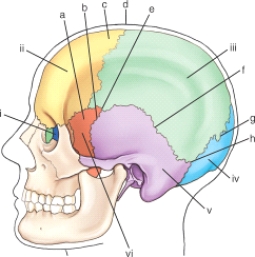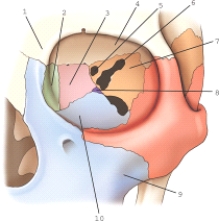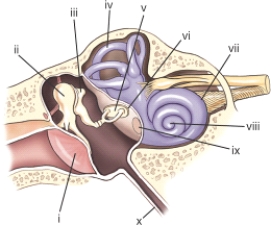A) Increase extension of the head and neck slightly.
B) Angle the CR 5° to 10° caudad.
C) Increase flexion of the head and neck slightly.
D) Have the patient open his mouth.
F) C) and D)
Correct Answer

verified
Correct Answer
verified
Multiple Choice
Which cranial bone possesses the zygomatic process?
A) Frontal
B) Sphenoid
C) Temporal
D) Ethmoid
F) C) and D)
Correct Answer

verified
Correct Answer
verified
Multiple Choice
Which cranial bone is labeled vi in this figure?
 (Anatomic structures are labeled i through vi and sutures a through h.)
(Anatomic structures are labeled i through vi and sutures a through h.)
A) Temporal
B) Occipital
C) Greater wing of sphenoid
D) Parietal
F) B) and C)
Correct Answer

verified
Correct Answer
verified
Multiple Choice
A patient enters the ED with a possible fracture of the proximal ramus of the mandible.Which of the following routines would best diagnose this fracture?
A) Parietoacanthial projection, axiolateral oblique projection with a 30° rotation toward film, and lateral facial bone projection
B) PA mandible projection, axiolateral oblique projection with a 45° rotation, and 35° AP axial projection
C) PA axial mandible projection, axiolateral oblique projection with no rotation, and a 35° AP axial projection
D) PA mandible projection, axiolateral oblique projection with a 45° rotation toward film, and submentovertex projection
F) B) and C)
Correct Answer

verified
Correct Answer
verified
Multiple Choice
A pediatric patient enters radiology for a paranasal sinus series.Because of her age,the child is unable to hold still for the projections even with the use of immobilization devices.The decision is to hold the child during each exposure.Which of the following individuals should be asked to hold the child?
A) Technologists
B) Referring physician
C) Guardian
D) Student
F) B) and D)
Correct Answer

verified
Correct Answer
verified
Multiple Choice
Which of the following points is NOT true about the oblique inferosuperior (tangential) projection of the zygomatic arches?
A) It requires both rotation and tilt of the skull.
B) A small focal spot should be used.
C) The AEC should not be used.
D) A grid must be used.
F) A) and C)
Correct Answer

verified
Correct Answer
verified
Multiple Choice
A radiograph of a parieto-orbital oblique projection for the optic foramen reveals that the optic foramen is projected into the inferior,outer orbital rim.Which of the following modifications is necessary to produce a more diagnostic image?
A) Decrease the extension of the head and neck.
B) Increase the extension of the head and neck.
C) Increase the CR angulation.
D) Decrease the CR angulation.
F) C) and D)
Correct Answer

verified
Correct Answer
verified
Multiple Choice
What is the classification of the joint found between the teeth and maxilla?
A) Synovial
B) Fibrous
C) Cartilaginous
D) Synarthrodial
F) A) and C)
Correct Answer

verified
Correct Answer
verified
Multiple Choice
Part 10 is part of which bone?

A) Maxilla
B) Sphenoid
C) Zygomatic
D) Ethmoid
F) All of the above
Correct Answer

verified
Correct Answer
verified
Multiple Choice
The most common radiographic sign for secondary osteomyelitis of the paranasal sinuses is:
A) polyps.
B) mucosal thickening.
C) deviation of the bony nasal septum.
D) erosion of the bony margins.
F) None of the above
Correct Answer

verified
Correct Answer
verified
Multiple Choice
MATCHING Select the imaging modality that would best demonstrate the following pathologies. -Recent bleeding within the brain
A) Nuclear medicine
B) MRI
C) CT
D) Ultrasound
E) Conventional radiography
G) All of the above
Correct Answer

verified
Correct Answer
verified
Multiple Choice
Which cranial bone possesses the sella turcica?
A) Temporal
B) Sphenoid
C) Ethmoid
D) Occipital
F) All of the above
Correct Answer

verified
Correct Answer
verified
Multiple Choice
A radiograph of a lateral projection of the facial bones reveals that the mandibular rami are not superimposed.What specific positioning error is present on this radiograph?
A) Tilt
B) Excessive flexion
C) Excessive extension
D) Rotation
F) None of the above
Correct Answer

verified
Correct Answer
verified
Multiple Choice
What CR angle is required for the Schuller method projection of the TMJs?
A) None; the CR should be perpendicular to the film.
B) 25° to 30° caudad
C) 15° caudad
D) 20° to 25° cephalad
F) A) and B)
Correct Answer

verified
Correct Answer
verified
Multiple Choice
MATCHING Select the imaging modality that would best demonstrate the following pathologies. -Most sensitive modality for detecting differences between normal and abnormal brain tissues
A) Nuclear medicine
B) MRI
C) CT
D) Ultrasound
E) Conventional radiography
G) B) and C)
Correct Answer

verified
Correct Answer
verified
Multiple Choice
The cochlea is labeled:

A) v.
B) vii.
C) viii.
D) ix.
F) A) and D)
Correct Answer

verified
Correct Answer
verified
Multiple Choice
Which plane or perspective is most often produced for a CT scan of the sinuses?
A) Sagittal
B) Transverse
C) Coronal
D) Axial oblique
F) None of the above
Correct Answer

verified
Correct Answer
verified
Multiple Choice
Match each of the following radiographic appearances with the corresponding pathologic indication.(Use each selection only once.) -Radiolucent areas within the bony cranium
A) Multiple myeloma
B) Paget's disease
C) Metastases
D) Pituitary adenoma
F) B) and D)
Correct Answer

verified
Correct Answer
verified
Multiple Choice
Which facial bone forms the majority of the hard palate?
A) Mandible
B) Palatine
C) Maxilla
D) Zygomatic
F) A) and B)
Correct Answer

verified
Correct Answer
verified
Multiple Choice
Which positioning line is placed perpendicular to the plane of the IR with a true lateral nasal bone projection?
A) OML
B) AML
C) Interpupillary
D) Midsagittal
F) B) and D)
Correct Answer

verified
Correct Answer
verified
Showing 41 - 60 of 181
Related Exams